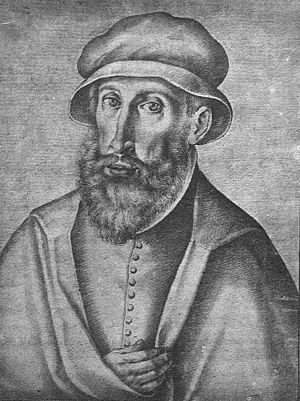Pedro Mexía facts for kids
Pedro Mejía (also known as Pero Mexía) was an important Spanish writer, thinker, and historian during the Renaissance. He was born in 1497 and passed away in 1551. Mejía is remembered for his wide-ranging knowledge and his popular books that shared information with many people across Europe.
Contents
Early Life and Education
Pedro Mejía was born and died in Seville, a city in Spain. He spent most of his life there and always showed a special love for Seville in his writings.
He went to universities in Seville and Salamanca. There, he studied subjects like history, literature, and law. Mejía was a very curious person who loved learning about many different topics.
A Famous Writer
Pedro Mejía was known for writing to other famous thinkers of his time. He exchanged letters with important people like Erasmus of Rotterdam.
In 1548, he received a special job. He became the official historian for Emperor Charles V. This meant he wrote down the important events and stories of the Emperor's court.
Silva de varia lección
Mejía's most famous book is called Silva de varia lección. This means "A Miscellany of Several Lessons." It was published in 1540 and quickly became a huge success across Europe.
This book was like an early encyclopedia. It was a mix of many different subjects. It included interesting facts and stories from history, science, and philosophy.
The book was so popular that it was printed many times. Within 100 years, it had 31 editions in Spanish. It was also translated into Italian, French, and English. This shows how much people wanted to read his work.
Mejía gathered information for his book from many ancient writers. He used ideas from famous thinkers like Plutarch and Pliny the Elder. He also included thoughts from his friend, Erasmus of Rotterdam.
Other Important Works
Besides Silva de varia lección, Pedro Mejía wrote other significant books. These included Historia imperial y cesárea (1545), which was a history of emperors.
He also started writing a history of Emperor Charles V. However, this book was never finished or published during his lifetime. Another work was Coloquios y Diálogos (1547), which means "Conversations and Dialogues."
Lasting Influence
Pedro Mejía's writings had a big impact on many later authors. His famous book, Silva de varia lección, was read by some of the greatest writers in history.
You can find traces of his ideas in the works of Miguel de Cervantes, who wrote Don Quixote. Even Shakespeare, the famous English playwright, and Montaigne, a French philosopher, were influenced by Mejía's wide-ranging knowledge.
See also
In Spanish: Pedro Mejía para niños


